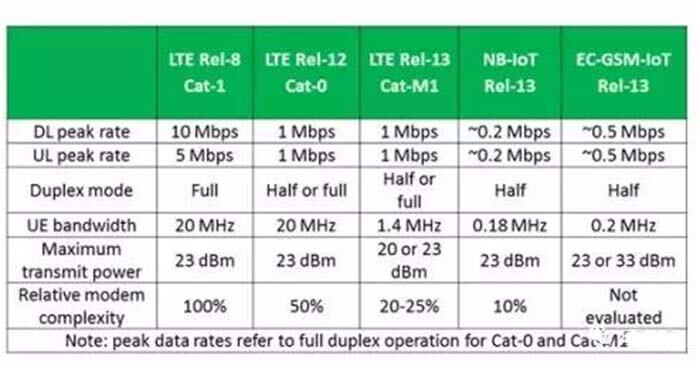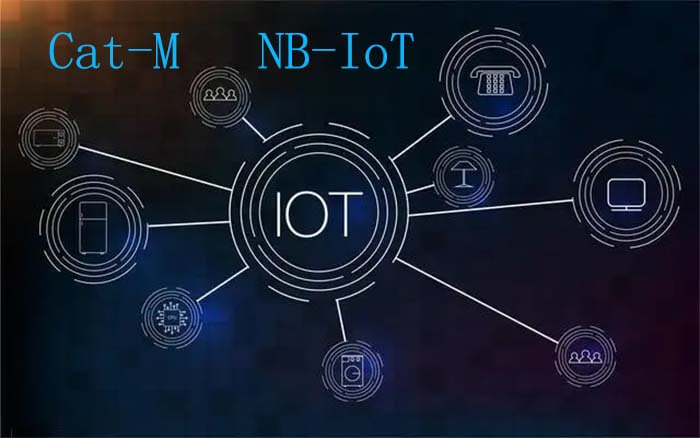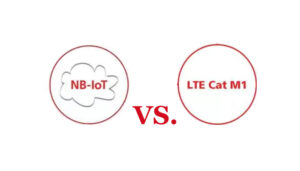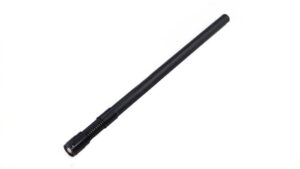This article talks about several key specifications of cellular IoT Cat-M NB-IoT including 4G LTE Cat-0, LTE Cat-1, LTE Cat-M1, and NB-IoT new cellular technologies for IoT.
Cellular IoT Technologies at a Glance Cat-0,Cat-1,Cat-M NB-IoT
1. Cellular IoT technologies for IoT communication and LTE
There are many technical solutions used in IoT applications. Various industries and technical standard organizations are developing corresponding IoT technical solutions, some are under development, some are still in prototype testing, and some technical solutions with independent intellectual property rights have been applied in the market.
IoT devices actually have the following six main characteristics.
(1) Simple design: low system complexity can ensure that IoT devices work properly in harsh environments.
(2) Low-cost: IoT devices are generally low cost and high volume.
(3) Large coverage: to ensure that the data of some meters and devices in the basement can be transmitted.
(4) Low-power consumption: most of the application scenarios need to use the battery function, and need to be able to work for years.
(5) Low rate: for example, in some meter reading applications, only a few tens of bytes need to be transmitted a day is enough.
(6) Massive device access: You can imagine the number of various meters and machines inside a cell is tens of thousands.
Although there are many communication technologies used for IoT, we have not seen any trend of unification so far.
But this situation may soon be broken, as 3GPP has finally started to take action on IoT by developing Release12 and Release13 standards in LTE enhancements to address the communication between different machines and devices (MTC) and the Internet of Things (IoT) needs.
The information about 3GPP technical standards for IoT is always fragmented, so I’ll do a summary here, and hope you can have a basic understanding of cellular IoT technology.
Why is a pure LTE network not ideal for IoT?
LTE was designed to address one primary requirement: it must be fast enough.
While the technology can meet the needs of mobile broadband communication, it cannot be used well in other applications such as wearable devices, industrial sensors, home appliances, and so on.
Such devices are characterized by their small size, and battery power, and are often placed in places with poor or no network coverage, such as basements.
In most cases, the IoT device in the home uses the local LAN or a nearby IoT concentrator to forward the data from the IoT device over WiFi, cable, DSL, and fiber.
However, there are some cases where this method does not work, for example, for basement-mounted power meters or industrial power meters, so it is better to be able to use an off-the-shelf cellular network as the backbone.
What is the difference between LTE and IoT?
Although GSM was and still is the technology used for many IoT communications, this technology is too old and sooner or later many network operators will switch it off.
This will only add the special features of IoT communications to LTE networks in the future, but LTE was not originally designed to handle thousands of machine devices inside a single sector or to support cheap low-complexity gadgets that only transmit very little data.
In the past few years, 3GPP has added several enhanced standards to LTE technology, some simplified and some completely new, to enable the connection of IoT devices, and these newly developed standards are able to meet several conditions as follows.
(1) Very low-cost RF modules for the devices, less than 5 USD.
(2) Deep indoor coverage, as well as greater coverage than the existing LTE
(3) Each sector supports a maximum of 50,000 devices, which will transmit only a few bytes a day.
(4) Ultra-low power consumption, for devices that only need to transmit a few bytes a day, the battery life should be up to 10 years,
(5) Support for devices operating at low rates, for example, with a maximum throughput of only a few hundred K per second, enabling simple and low-cost design, and the ability to greatly improve RF sensitivity (to achieve deep indoor coverage).
It is clear that one IoT RF standard alone cannot meet all IoT application scenarios. Some IoT devices want to transmit data more frequently, for example using a rate of several hundred K per second for transmission, although this will sacrifice some power consumption and reduce indoor coverage.
Some IoT devices may only need to transmit 50 bytes of data in a day, but these devices may be so far away from the base station or installed in some deep basements that LTE networks with 10 or 20 MHz bandwidth cannot cover them.
To meet these two extreme cases, 3GPP has developed some enhanced standards.
(1) LTE Category 1: LTE Cat1, this device can reach a rate of 10Mbps
(2) LTE Category 0: LTE Cato, which can reach 1Mbps
(3) LTE Category M1: LTE Cat-M1, this device can reach 1Mbps and is optimized to reduce power consumption.
(4) LTE Category M2, LTE Cat-M2, also known as Narrow-Band IoT, LTE Cat-NB, or NB-IoT, has a rate of only a few hundred Kbps, but is greatly optimized in terms of power consumption and can expand indoor coverage.
What the above four types of devices have in common is that they can all communicate with the currently deployed LTE network, and only need to upgrade the software of the base station and core network.
One important point is that the base station can handle both the traditional LTE network, the LTE-Advanced mobile broadband network, and the enhanced IoT network mentioned above. In short, there is no need to design a specific network for IoT communication.
2. LTE Cat-1 and Cat-0 devices
We first introduce two early 3GPP communication specifications for IoT applications and their application scenarios.
LTE Cat-1 devices In fact, in the very early 3GPP LTE standard, the EUTRAN specification (3GPP Release 8) included a device called LTE Category 1 (Cat-1), which was designed to be simple and power-efficient, and its maximum speed could only reach 10Mbps.
In order to reduce complexity, LTE Cat-1 is the only device type that can use a single antenna in 2008, which means it does not support MIMO (Multiple In Multiple Out).
These are theoretical descriptions, but in the past 8 years, this type of device is not very popular, so much so that it has never been seen in the market.
LTE Cat-0 devices and PSM After many more years, 3GPP went one step further in Release 12, defining LTE Category 0 (Cat-0) devices.
This device is further trimmed to 1Mbps and uses a half-duplex mechanism which, although optional, greatly reduces cost, complexity, and power consumption due to the use of an antenna transceiver switch (switch) instead of a full-duplex filter, which prevents the device from transmitting and receiving simultaneously.
In addition, the standard also defines the power-saving mode, which extends the LTE specification, adding an RF interface state.
Previously, the device connection mode was such that in one case an RF connection was established with the network, and in the other case no connection was actually established, but a logical connection could be established by keeping its IP address.
Even if there is no connection, the device can still receive paging packets from the base station and be woken up to work.
PSM extends this mechanism by providing that the device can continue to hold its IP address and not receive paging requests for a very long period of time, which can be set to a maximum of 12.1 days.
The disadvantage of this is that when in the PSM state, the device is unable to communicate.
Because different applications require different PSM times, the device needs to set a timer value to control how long it needs to remain communicable before entering PSM.
The second timer value is sent out inside the LTE Attach Message and indicates the duration of PSM. The network can confirm and modify these values inside the Attach Accept message.
Although PSM does not require modifications to the physical layer of the RF interface, it does require modifications to the NAS so that, when data comes in, the core network knows which devices are ready to communicate and which are not.
LTE Cat-1 devices can work on all current LTE networks, but LTE CAT-0 devices are only specified in 3GPP Release 12, so software updates are required on the network side to support the standard.
3. LTE Cat-M1 devices
The 20MHz bandwidth of standard LTE devices is a major reason for the increased complexity and power consumption of LTE products. All LTE device types are required to be able to detect the control channel or receive data in a channel that is up to 20MHz wide.
For IoT devices, the rate is of secondary importance.
LTE Category M1 devices LTE Cat-M1 devices, which are developed in the 3GPP Release 13 standard, have a maximum operating bandwidth of only 1.4MHz, and the maximum rate that can be supported is 1Mbps.
This requires modifications to the physical layer of LTE, as the standard LTE control channel generally operates at the standard LTE channel bandwidth (e.g. 20MHz).
To meet the needs of Cat-M1 devices, the LTE standard adds several new control channels that are not visible to standard LTE devices and have a bandwidth of only 1.4 MHz.
It is important to note that the total occupied spectrum width for LTE is still 20 MHz, but Cat-M1 devices only occupy 1.4 MHz of that bandwidth.
Signal information and user data can be duplicated in order to extend the sector coverage or to further improve indoor coverage, but this adds additional redundancy.
Like LTE Cat-0 devices, LTE Cat-M1 devices are also subject to software upgrades to the network. Without an upgrade, LTE Cat-M1 devices cannot even search the network because no broadcast data is available for the new LTE Cat-M1 signal channels.
Many sources mention LTE Cat-M devices, so what is the difference between CAT-M and CAT-M1? I think they are referring to one thing.
Some people’s view is that Cat-M was renamed LTE Cat-M1 because the 3GPP IoT working group introduced a new narrowband IoT standard in the Release 13 regulations, which is now called NB-IoT, also called LTE Cat-M2.
4. NB-IoT/LTE Cat-M2 devices
In fact, the previous three types of devices are only minor modifications to the existing 3GPP LTE standard, and the NB-IoT working group is committed to proposing a more radical technical solution.
Within 3GPP, there are several technical solutions for NB-IoT under study and research, and inside 3GPP TR45.820, there are more than 500 pages detailing these technical solutions.
In September 2015, 3GPP finally reached an agreement to choose a solution from among them. Details of this decision are now archived in the NB-IoT working group description document, which can be found in RP-151620.
Ultra-narrowband that can be used anywhere, the cost of the IoT module should be very low and the rate can be very low so that power consumption can be reduced and indoor coverage can be enhanced.
NB-IoT is a revolutionary breakthrough for LTE technology which was once used for mobile broadband applications, the working bandwidth of NB-IoT is only 180KHz.
This bandwidth is too small compared to the 20MHz bandwidth of mobile broadband LTE, not to mention the carrier aggregation devices with three times the 20MHz bandwidth, which can now bind three downlink channels.
Not only that, but NB-IoT channels also use the same orthogonal frequency division multiplexing technology as LTE physical layer, with the same subcarrier space, OFDM symbol period, time slot format, time slot length, and subframe duration, and still use the same LTE RLC, RRC and MAC protocols.
Deployment flexibility and Backward Compatibility Another significant feature of NB-IoT’s 180KHz bandwidth is that it can be deployed in three different scenarios, as shown in Figure-1.
One option is to deploy one or several NB-IoT channels within the LTE bandwidth.
The second option is to use a protected channel of the full LTE channel.
The third option is to directly replace a GSM channel with an NB-IoT channel.
All three deployments are backward compatible, meaning that LTE devices that do not have NB-IoT features will not see NB-IoT channels in the LTE primary channel, or in the protected bandwidth.
Traditional GSM devices will also not detect NB-IoT carrier signals inside the 180KHz GSM carrier signal. These devices will only recognize the NB-IoT signal as noise.

Massive device access and low rates In addition to the narrow bandwidth, NB-IoT’s added channels, and access management process are designed to support the connection of 50,000 devices within a sector – yes, a sector, so you can imagine that the data each device can transmit per day is very low.
According to Qualcomm, NB-IoT devices can achieve rates of 500Kbps downstream and 40Kbps upstream, provided the signal quality is good.
This is a theoretical value, but in practice, the rate per device is even lower because many devices occupy a channel, and the NB-IoT is designed specifically to work with very low signal strength, which has to be sacrificed to achieve the rate.
What is the usage of the Cat-M NB-IoT carrier wave?
For downlink transmission, the channel uses OFDM modulation with several 15KHz spaced subcarriers, also known as “tones”. For uplink transmission, the mobile device can use the standard 15KHz carrier spaced subcarriers or it can also use 3.75KHz carrier spacing in combination with the SC-FDMA modulation used in LTE.
When to use the 3.75KHz carrier interval? When the terminal equipment can receive data from the base station, but often the base station cannot receive the data from the terminal due to the small antenna of the equipment, low transmit power, or deteriorating signal conditions caused by the environment.
By using 3.75KHz carrier frequency spacing, the transmit power of the terminal device can be more concentrated in a narrower bandwidth, which can improve the line budget and provide the success rate of the data received by the base station.
Some scenarios with a very low signal are called “extreme coverage”, and NB-IoT can work in environments that are 20dB worse than the GSM critical operating environment.
For those terminal devices that are more concerned about power consumption, NB-IoT defines Class5 devices, limiting the maximum transmit power to 20dBm (0.1 watts).
In addition, depending on the site RF environment and rate requirements, the device can communicate on a single carrier or 3 or 6 multi-carriers. According to our previous description, we will find that the traditional LTE channel will not be used as NB-IoT.
Although some of the basic concepts (like random access, and assignment of transmission opportunities) are the same, the channel packet format and channel deployment for NB-IoT are completely new.
RF security and backward compatibility From the perspective of RF security, NB-IoT fully adopts the authentication and encryption mechanisms of LTE, which rely on SIM cards.
Smaller terminal devices will use embedded SIM cards, which serve the same purpose as ordinary SIM cards, but are smaller in size and can be soldered directly to the circuit board.
NB-IoT is not backward compatible with LTE, GSM, and UMTS, so NB-IoT devices can only communicate with devices that support NB-IoT protocol.
In practical applications, terminal devices can support all the above-mentioned standards by adding the necessary circuits, but reselection and switching are not supported.
In summary, Compared with those IoT communication protocols previously developed by 3GPP, NB-IoT is by far the most comprehensive and closest to the implementation of a standard.
NB-IoT is optimized mainly in terms of power consumption, cost, and low rate, and he provides a solution for hardware manufacturers in the next two years, which also allows many machines and devices to add communication functions, and there is no need to add additional local concentrators and so on.
Table-2- is a comparison of the parameters of several technologies discussed earlier.

Table-2- Technical comparison of several mainstream technologies for cellular IoT
The upper layer of the RF protocol stack of NB-IoT also supports IP protocols.
Due to the low rate defined by NB-IoT and the fact that it may take 7s to transmit an IP packet as mentioned in one of our previous papers, TCP transmission is not applicable to most NB-IoT application scenarios, and UDP is likely to be widely adopted in the IoT field.
But IP is still important, and IoT devices can connect directly to the Internet without some intermediate devices. many users, like me, want to have a kind of smart device that they can communicate directly, instead of needing a device to translate higher-level protocol stack content between the end device and the Internet.
What is the Difference Between Cat-M NB-IoT?
The three new carrier network services that 3GPP is now explicitly using for loT are Narrowband IoT (NB-IoT or LTE Cat-NB1), LTE Cat-M1, and LTE Cat1.
It is important to note that the roaming agreements already implemented by operators do not necessarily cover all these LTE loT technologies. Roaming also takes longer to connect.
In June 2016, the 3rd Generation Partnership Project (3GPP), a telecommunications standardization organization, announced that it had completed the NB-loT, eMTC (aka LTE Cat-M1), and EC-GSM-IoT technology standards to address the application needs of the IoT market.
The standards are part of the LTE-advanced Pro Network Protocol Release 13 (Release 13).
While LTE CAT-M1 and NB-IoT are similar in cost, LTE-Cat M1 is slightly more expensive at a realistic 350kbps rate.
NB-IoT has a lower bandwidth of less than 150kbps, with some modules promising 27kbps. unlike LTE Cat-M1, NB-IoT cannot smoothly switch connections between cell towers.
However, if devices are deployed on NB-IoT and must move, even if a stationary sensor using a tower is the target use case, the application layer can still switch connections between towers. nb-IoT has lower transmission current consumption, longer sleep time (the 30s), and latency of 1.4 to 10 seconds than LTE Cat-M1.
Since LTE Cat-M1 supports Voice over LTE (VoLTE), LTE Cat-M1 has higher transmission current consumption, 10 to 15 ms latency for machine-to-human communication or vice versa.
Besides the Cat-M NB-IoT in Cellular IoT Technologies article, you may also be interested in the below articles.
PCB Antenna VS. External Antenna
Ceramic Antenna VS. PCB Antenna, A Comparison Guide
Wifi vs. 5G, is 5G better than Wifi?
Mobile Networks’ Evolution From 1G To 5G




